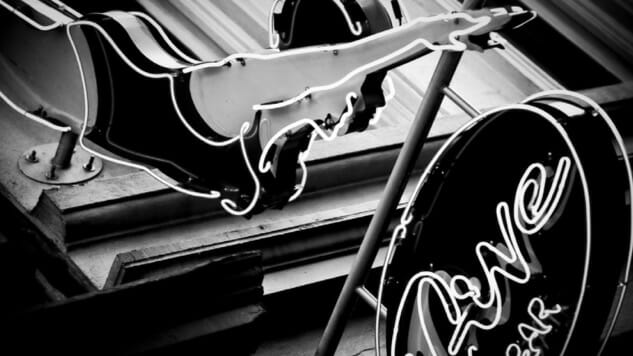
The holiday season sees tourists flock to long-established nightlife zones in Europe’s busiest destinations. ‘Let’s take our winter break in Barcelona!’ they say—buying flights, booking Airbnbs and basking in the dollar-to-euro rate. Couples plan to reconnect, rekindle the flame and seal the deal over cava and tapas in the Barri Gòtic, only to end up politely fighting for table space with hordes of other reconnecters, rekindlers and not-quite deal-sealers.
This happens across Europe’s historic centers-now-bar-quarters, on the terrace cafés of the Grand’Place in Brussels and in the faux ruin bars of Budapest’s Jewish District.
So let us take you to nearby hoods where locals mingle. They won’t be empty (hey, who wants to drink alone?), but these five hubs should be a-buzz with lively chatter in the native tongue rather than aurally sandblasted by a compatriot barking for something with Kahlúa.
Brussels/St-Gilles
Groaning under constantly crowded café tables, the main square of Brussels, Grand’Place, retains its charm but not always its composure. The stress is easily alleviated. Push through to nearby Bourse and take tram number 3 or 4 to St-Gilles.
A village within Europe’s capital, the district of St-Gilles feels like a charming provincial French town on market day, an illusion completed by the farmers’ stalls that set up on the pretty main square, the Parvis. Bars as fine any in this beer metropolis guard two corners.
Classier Brasserie Verschueren glimmers with art-deco touches, one wall bright with the primary colors of Belgian football clubs in league-ladder order. Timeless might be the word you’re looking for.
Scruffier sister Brasserie de l’Union is named after revered local team Union Saint-Gilloise. Screaming Jay Hawkins makes more of a decorative impact than the touches of yellow and blue, but that’s Screaming Jay Hawkins for you.
Barcelona/Sant Antoni
First came the Barri Gòtic then, across the Rambla, raw Raval, tourist tides washing over each by the decade. One over from Raval is Sant Antoni. Local to the point of parochial, unlike Raval Sant Antoni is yet unswarmed by pickpockets.
Its address features on bottles of local Moritz beer that has outmuscled formerly ubiquitous Estrella Damm. Created by an Alsatian of the same name, Moritz also moved from Raval to Sant Antoni, in 1856, its former factory now a quite wonderful brewery bar, wine bar, bakery and late-night events hub.
Kraków/Podgórze
The last notable foreigners to venture over the Vistula from Jewish quarter Kazimierz to former ghetto Podgórze were Steven Spielberg and crew, filming Oscar smash ‘Schindler’s List’ in its forgotten surroundings. Here stood the empty Schindler factory. A frightened young Roman Polanski once lived around the corner. Tourist-friendly Kazimierz gained global attention. Its bar hub around Plac Nowy became as packed as any in Prague or Budapest.
Five minutes by rattling tram over Pilsudski Bridge, Podgórze remained neglected, only now being repopulated by scenesters. Integral to this trend has been Drukarnia. Part bohemian pub, part jazz bar, part terrace café, Drukarnia’s flag-planting in Podgórze was a sign. Young creatives arrived to suck on raspberry-flavored beer through thin straws. Everyone gravitated here.
Around it, galleries and arty café-bars have blipped on and off the radar, a mainstay being the Kawiarnia Lwowska, creating the charm of pre-war Lvov with Ukrainian beers and film projections.
Budapest/District VIII
Three tramstops from Central Europe’s busiest bar hub, Budapest’s District VII, District VIII remains ungentrified despite the fancy lampposts.
Alongside Harminckettesek tere, Krúdy Gyula utca was the domain of seminal club Tilos Áz Á. Next door today, Lumen is all fine coffee, artsy photos and occasional DJs.
The other side of the tramstop is terra incognita. Stray too far and it’s unlit streets and broken-down doorways. Closer to Harminckettesek tere, Zsiga is yet undiscovered by coin-counting interrailers. Witty, kitsch and romantic, its customer base comprises thirtysomething Hungarians who have long chosen drink and daring affairs over life’s dull equations. At night’s end they may break out in communal song, say, “Szomorú vasárnap” or “Gloomy Sunday.”
Across Baross utca, Gondozó kert (Vajdahunyad utca 4) is that rare beast, a bearable ruin pub, its staff transported from the revered Tüzraktér, its mainly Magyar drinkers gathered under a ceiling of colourful umbrellas.
Vienna/Neubau
During the early reign of Barry Manilow, Vienna’s Bermuda Triangle was equally à la mode, a cobblestone quarter of foreigner-friendly pubs by the Danube Canal. While Manilow and the Bermudadreieck still thrive, you need suffer them no longer.
From nearby Schottenring, a direct hop on the U2 line takes you to Volkstheater, gateway to Neubau, Vienna’s design district with bars to match. We’re not talking Scando-cool and stark white, but lived-in locals with a touch of retro class. Take, for example, the Espresso, an affectionate recreation of a 1950s coffeebar where bequiffed teenagers would woo jazz-jiving floozies. Early-evening cocktails preface DJs way past bedtime.
Further down Burggasse, former kitsch Magyar resto Ungar Grill has been transformed into an alternative hive of live sounds and original art thanks to Darija Kasalo from Vukovar, Croatia.
On the same strip, Wirr is sassy bistro (with foosball) by day, basement Club Dual by night, enticing a cross-section of Schilling-conscious Viennese.
Top Image: Thomas Hawk, CC-BY
Budapest-based Peterjon Cresswell is responsible for Libero, a global travel guide for soccer fans.